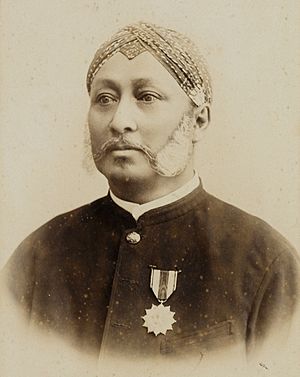Regency (Indonesia) facts for kids
A regency (called kabupaten in Indonesia) is a special area in Indonesia. It's like a county or a district in other countries. Regencies are directly under a province. They are on the same level as a city (kota).
Regencies are further divided into smaller areas. These smaller areas are called districts (Kecamatan). In some parts of Indonesia, like the Papua region, they are called Distrik. In the Special Region of Yogyakarta, they are known as Kapanewon.
The English word "regency" comes from the time when Dutch people ruled Indonesia. During that time, these areas were led by officials called bupati. These bupati were also known as regents. In Dutch, these areas were called regentschap. The local Indonesian name for them was kabupaten.
Before the Dutch arrived, bupati were important local leaders. They were like lords under the kings in Java. When the Dutch took over, they reduced the power of the kings. This made the bupati the most important local leaders. They were not fully independent rulers. The Dutch claimed control over their land. But in reality, bupati acted much like small kings. They had fancy clothes, palaces, and a lot of power.
Contents
Where the Name Comes From
The Indonesian title bupati comes from an old language called Sanskrit. It's a shorter version of bhumi-pati. In Sanskrit, bhumi means 'land' and pati means 'lord'. So, bhumi-pati means 'lord of the land'.
In Indonesia, bupati was first used in Java. It referred to local rulers in old kingdoms. One of the first times it was written down was in the Telaga Batu inscription. This old stone writing is from the Srivijaya period. It mentions bhupati as a title for local rulers. These rulers were loyal to the kings of Srivijaya.
Other similar titles used in old Indonesia were adipati (like a 'duke') and senapati (like a 'general' or 'army lord').
Before Indonesia Was Independent

During the Dutch colonial period, regencies in Java were grouped into bigger areas. These were called residencies. Each residency was led by a European official called a "resident." These residents were supposed to advise the bupati. But in reality, the bupati had to follow Dutch orders. This was true for anything important to the Dutch rulers.
The relationship between the Dutch and the bupati was a bit tricky. The Dutch government had all the legal and military power. But the bupati often had a higher official rank than the Dutch assistant-resident. The assistant-resident was supposed to advise them. Yet, the bupati had more direct influence over the local people.
After Indonesia became independent in 1945, the terms bupati and kabupaten were used everywhere. They became the names for the administrative units below the residency (karesidenan).
Recent Changes
Since 1998, after the fall of Soeharto, Indonesia has seen many new regencies created. This process is called pemekaran (which means 'division'). People wanted more local control. So, new laws were passed in 1999 to allow this.
Because of these changes, the number of regencies (and cities) grew a lot. In 1998, there were about 300. By 2014, there were 514! At first, people liked this idea. But later, it became a bit controversial. Creating so many new regencies was expensive. It also didn't always bring the benefits people hoped for.
Many government officials felt that creating new regencies needed to slow down. Some even thought it should stop for a while. However, local politicians still strongly supported creating more. Since 2014, no new regencies or independent cities have been created.
Since 1998, a lot of power has been given from the central government in Jakarta to the local regencies. Regencies now play a very important role. They provide many services to the people of Indonesia. Also, since 2005, people can directly vote for their regents and mayors. Before that, local councils chose the leaders.
Facts and Figures
As of 2020, Indonesia has 416 regencies and 98 cities.
- 120 regencies are in Sumatra.
- 85 are in Java.
- 37 are in Nusa Tenggara.
- 47 are in Kalimantan.
- 70 are in Sulawesi.
- 17 are in Maluku.
- 40 are in Papua.
See also
 In Spanish: Kabupaten para niños
In Spanish: Kabupaten para niños
- List of regencies and cities of Indonesia
- City status in Indonesia
- Subdivisions of Indonesia
- Other similar administrative divisions found outside Indonesia:


